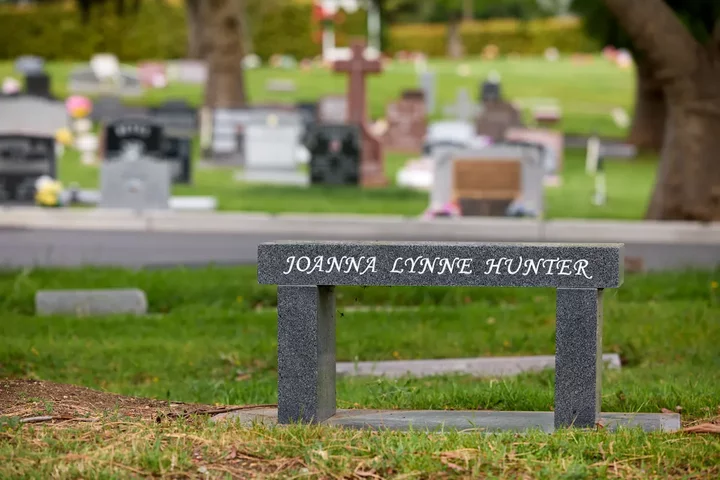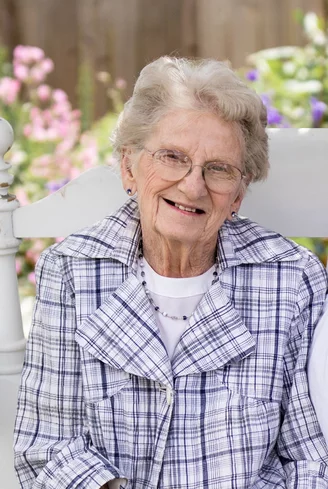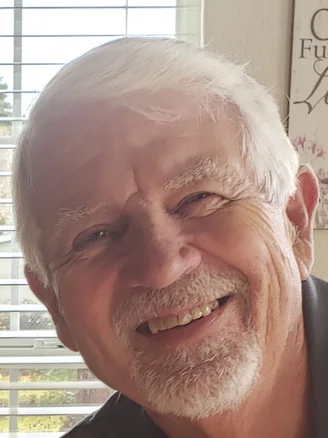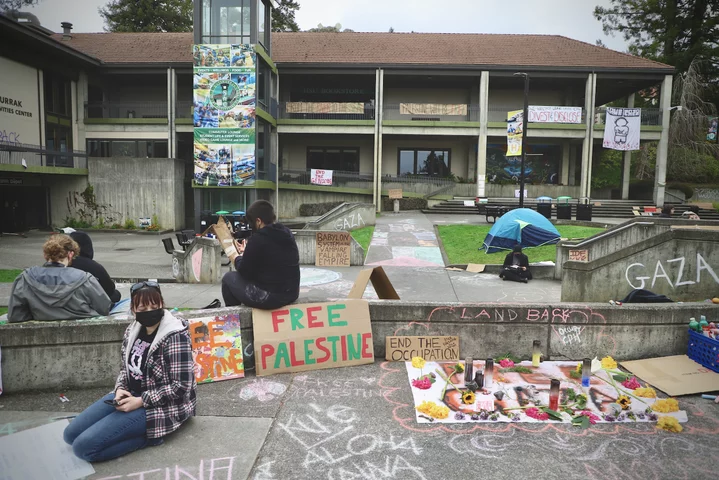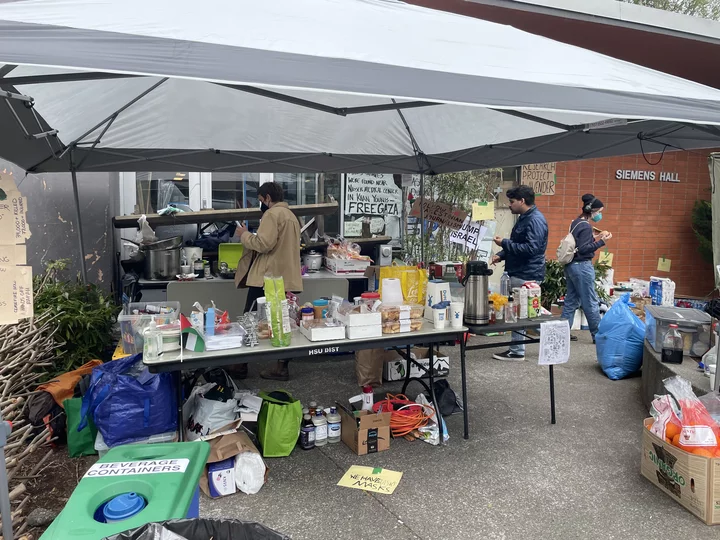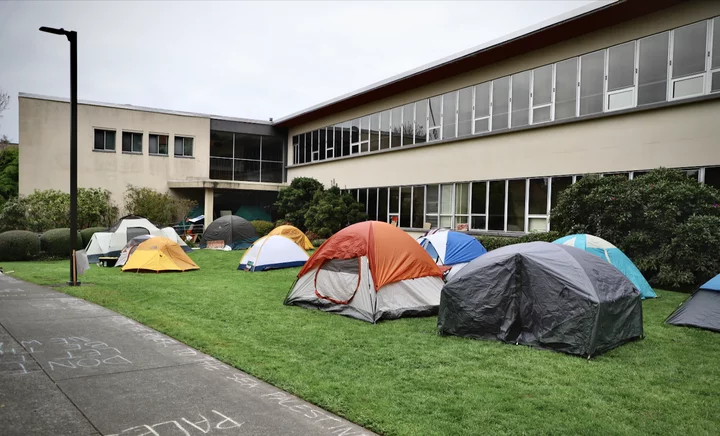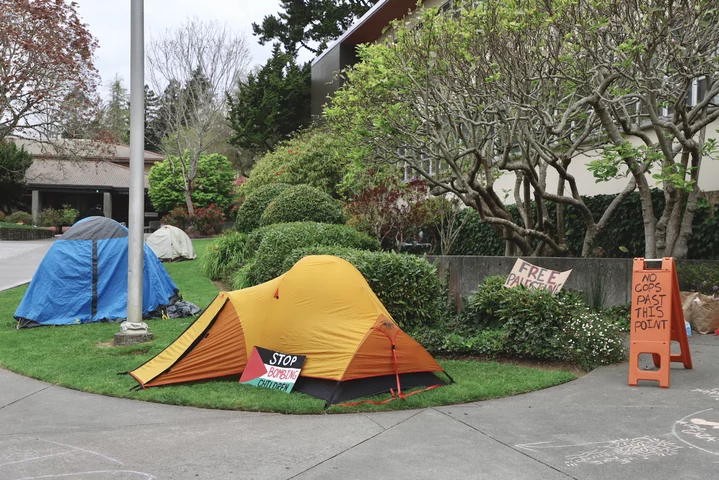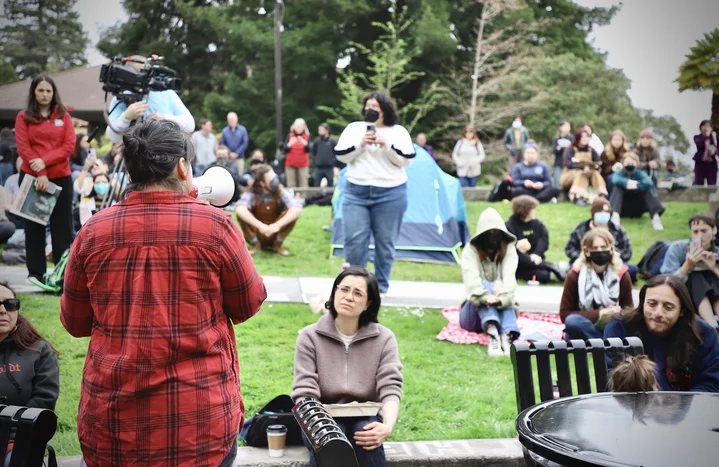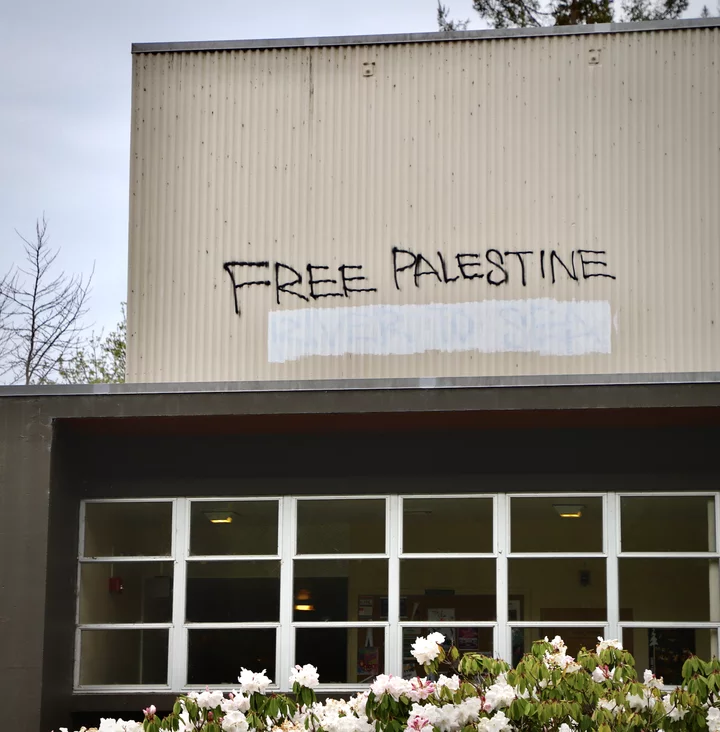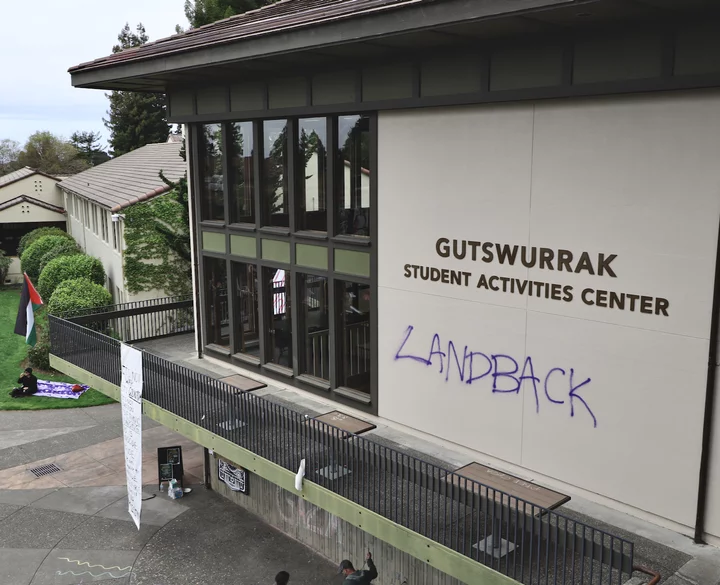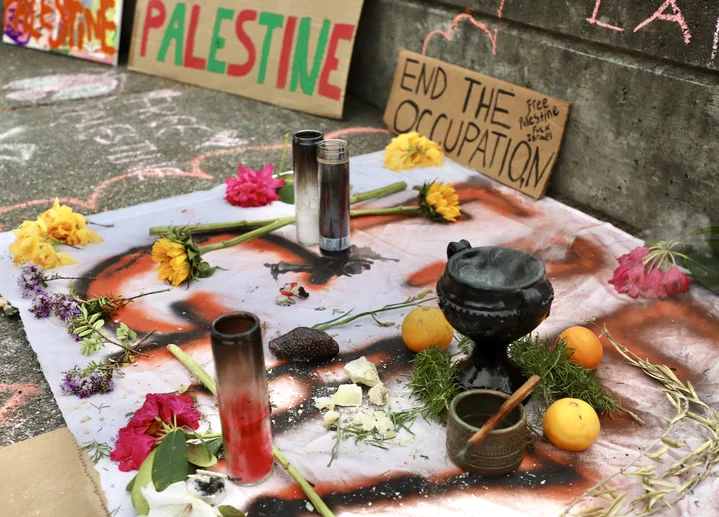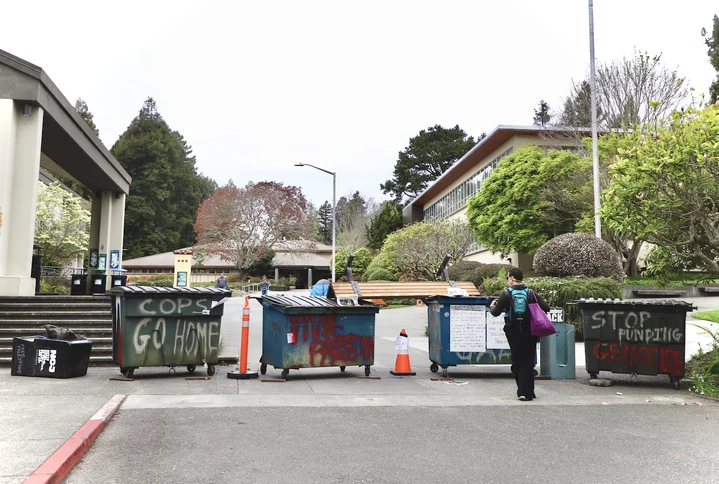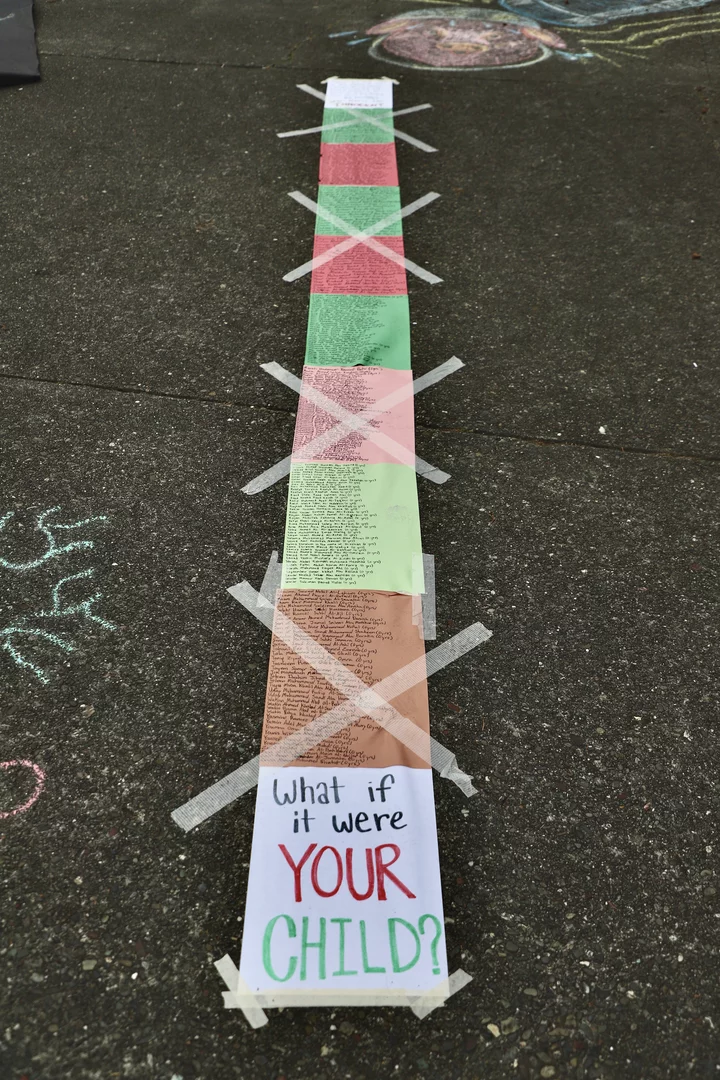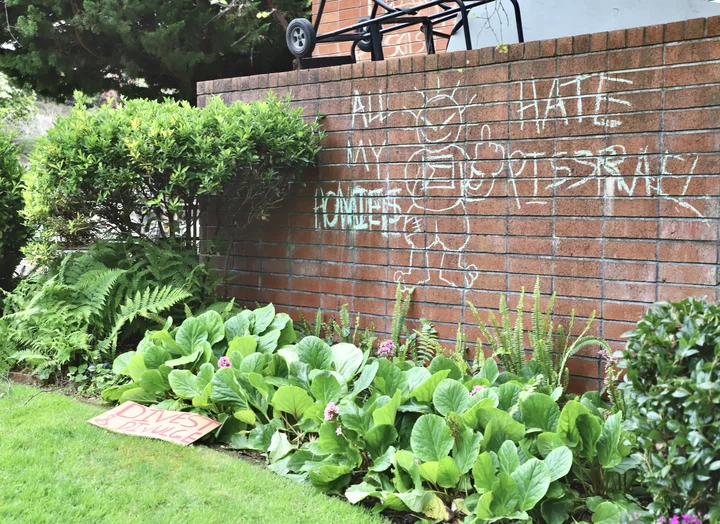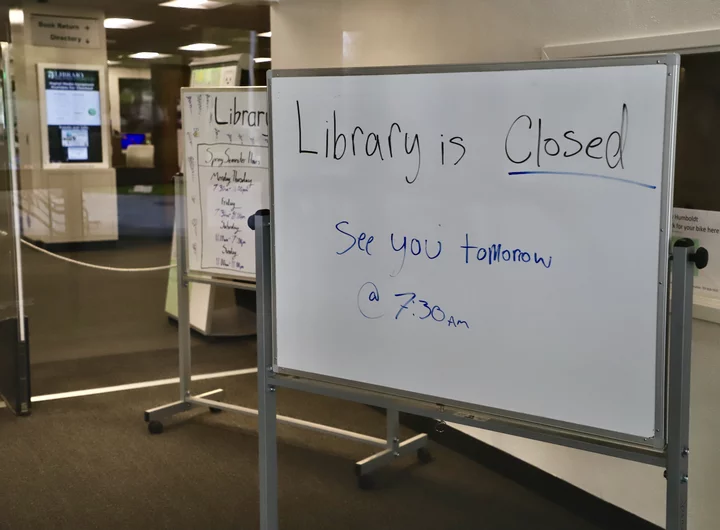Who’s Selling Your Digital Data? California Gives You Tools to Protect Your Online Privacy
Khari Johnson / Thursday, April 25, 2024 @ 7 a.m. / Sacramento
Illustration by Adriana Heldiz, CalMatters.
If you visited a Planned Parenthood in the continental United States in the past few years then the company Near Intelligence, a data broker, probably knew it — and may have sold that information to anti-abortion activists. If you attended certain houses of worship or patronized particular pharmacies, the data broker known as Outlogic allegedly sold that information.
Near Intelligence filed for bankruptcy in December. Outlogic agreed to a settlement with the Federal Trade Commision to stop selling user location data, while insisting regulators had found “no misuse of any data.” Both were among nearly 90 companies on the latest version of the California data broker registry that self-reported selling data about where people are or have been.
For the first time this year California requires data brokers — companies that knowingly collect and sell consumer’s data to third parties — to report if they collect location data. New state transparency requirements that kicked in this year also revealed that roughly two dozen companies collect personal data about children and about a dozen collect reproductive health data about people who are pregnant.
Do data brokers somewhere have data about you? Almost certainly. Most everywhere you go on your digital journey will collect traces of information about you. If you’ve been on the internet in the past few years, you’ve probably seen a bunch of notices asking if it’s okay for the website you’re on to collect your “cookies” — information that allows the website to remember you, essentially. Some apps on your phone may track your location. It’s hard to say precisely what information about you is where because there are so many variables — your privacy settings, the sites you visit, what you buy and from whom, etc. — but data brokers are in the business of finding, collecting, and selling that data to other businesses.
Brokers sell your web activity and other personal information to companies that may target advertising to you or make important decisions about your life, such as whether you get an apartment, whether your activity is labeled fraudulent, or how you’re treated by insurance companies.
The market is largely unregulated.
Selling data about people is the cornerstone of the modern internet economy, powering targeted advertising based on insights gleaned from personal data. Media investment company GroupM forecast $258 billion in digital advertising revenue this year.
To give people visibility into who sells their personal data for profit, four years ago California started requiring data brokers to register once a year. Since then, a new registry has come out each year based on those submissions.
The latest registry debuted one month ago with more detailed information and is now maintained by a relatively new state agency. A law passed last fall introduces new consumer rights and more stringent requirements for brokers.
Here are some important things to know:
How can data brokers harm you or your loved ones?
Data brokers can sell data to bad actors ranging from scam artists to adversarial foreign governments. In testimony to a congressional committee one year ago, Georgetown Law Center associate professor Laura Moy said data brokers selling information to law enforcement agencies could amount to a violation of the Fourth Amendment right to live free from unreasonable search and seizure.
From Beijing to Brussels to Washington D.C. and U.S. state capitals, government regulators are creating registries and business reporting rules that aim to prevent privacy violations or harmful forms of artificial intelligence. Privacy advocates have urged the creation of a national data broker registry with the Federal Trade Commission for years, but no such registry exists yet.
Who protects my privacy rights?
California voters passed a ballot measure in 2020 that gives consumers the right to access information collected about them, delete or modify that information, or tell a broker they cannot sell or share that information. Consumers can initiate the process by sending an email to a point of contact listed on the registry website. Then they have to present a copy of their ID like a driver’s license to prove who they are. Consumers and people under 18 can also work with an authorized agent, somebody who makes data deletion requests on their behalf. Companies like Transcend and nonprofit organizations like Consumer Reports offer consumer data deletion services.
To enforce these rights, the ballot measure created the California Privacy Protection Agency and a five-member board to govern its activity.
Companies that buy, sell, or share the personal data of at least 100,000 Californians or get a majority of annual revenue from selling data are required to comply with the consumer privacy law.
What’s new?
The most recent changes to California’s data broker registry — which took effect in January — require brokers to disclose whether they sell data about kids, pregnant people, or anyone’s geolocation data.
But relatively soon — at the speed state governments operate — consumers should be able to delete data collected about them.
Right now, consumers must go to hundreds of data brokers one at a time if they want them to delete their data.
Last fall, Gov. Gavin Newsom signed the Delete Act giving consumers a way to delete data from all registered brokers by using a single tool or website.
Under the law — authored by state Sen. Josh Becker, a Democrat from Menlo Park — the state’s privacy agency must launch a website by 2026 that allows Californinans to delete their data in 30 seconds or less. The Delete Act doubles the cost if data brokers fail to register to $200 a day as well as costs associated with action brought by the state attorney general. By 2028, audits must verify that data brokers are complying with the Delete Act.
The other major change is that the Delete Act requires brokers to delete any information they collect about a consumer, not just information shared directly from a consumer, closing what privacy advocates called a crucial loophole that existed in the right to delete granted to consumers under the California Consumer Privacy Act.
The law also shifts responsibility for maintaining the registry from the Department of Justice to the California Privacy Protection Agency. That means that power to determine which companies fail to register and comply with state privacy law or the Delete Act is decided by enforcement officers within that privacy agency.
And it’s up to the agency to decide whether companies should register as data brokers.
The enforcement division has received more than 1,200 complaints from July 2023 to February 2024, according to a staff update last month. The majority of those complaints concern the right to delete data collected about individuals.
Is California’s data broker registry comprehensive?
Since data brokers do not have a direct relationship with consumers, most people have never heard of companies that buy and sell data. But the registry is not comprehensive, not yet at least.
The registry that launched March 1 includes roughly 450 businesses and email points of contact. Brokers were required to register by Jan. 31, but in a meeting held last month, privacy protection agency attorney Liz Travis Allen warned that “If you look at the whole universe of every data broker, we don’t have that list. But that would be something we can enforce on, to figure out who isn’t registered and should be.”
The 2023 registry maintained by the state Justice Department listed 550 companies.
Privacy Rights Clearinghouse head of privacy Emory Roane was a co-sponsor of the Delete Act. He said it’s “really cool” that the privacy protection agency data broker registry illuminates metrics that you couldn’t see before like the number of companies that track your location or collect data about kids and people who are pregnant, or that the credit score agency Experian collects all three. But he said the registry is clearly incomplete. The state of Vermont defines a data broker the same way as California, also maintains a data broker registry registry, and created its registry around the same time as California, but it lists 660 companies.
That discrepancy “suggests that there is a problem with non-registered data brokers,” he told CalMatters in an email. “As to how many brokers aren’t registered, well, that’s anyone’s guess. It could be dozens, hundreds, or even thousands.”
A January Consumer Reports study involving nearly 700 volunteers who shared the data Meta collects about them on Facebook and Instagram found that the average person is tracked by more than 2,220 companies.
How can I tell a data broker to delete my data?
Each company maintains its own privacy policy, but deleting the data it collects on you can be as simple as sending an email to the broker, whose contact email is listed on the registry. California law requires the broker to respond within 90 days.
You can also use third parties tools like the Permission Slip app to tell data brokers to delete your data.
Brokers must detail how you can delete or modify data in a privacy policy listed on their website. If a business fails to act in those 90 days, you can file a complaint with California’s privacy protection agency.
To quickly view the complete list of companies that sell kids data, reproductive health data, or geolocation data, toggle the arrow buttons at the top of the screen on California’s online registry site.
How do I delete data collected about my kid?
A parent or guardian who wishes to make a deletion request on a child’s behalf may do so by following the same steps necessary for any other Californian, but a business may require them to verify their identity with a government-issued ID card or phone or video call with a trained professional.
What’s next in California?
The state’s privacy protection agency is already developing a single-click data deletion option. The enforcement division will contact companies they believe should be part of the registry or face fines, fees, or legal action.
How aggressive will California’s consumer privacy agency really be? One test is how frequently it issues fines and fees for brokers who fail to register. Privacy protection agency deputy director of external affairs Megan White wouldn’t say when enforcement officers will contact companies that they determined must register as data brokers and are in violation of the law.
Roane said he hopes for, and expects, “eager enforcers more vigilantly holding non-registering and non-conforming data brokers to account.”
In July, California will begin requiring data brokers to publicly report on their own websites the number of requests they receive to delete, modify, or share what data they collected about individuals, and the median amount of time it takes to fulfill those requests.
###
The Calmatters Ideas Festival takes place June 5-6! Find out more and get your tickets at this link.
CalMatters.org is a nonprofit, nonpartisan media venture explaining California policies and politics.
BOOKED
Yesterday: 2 felonies, 6 misdemeanors, 0 infractions
JUDGED
Humboldt County Superior Court Calendar: Yesterday
CHP REPORTS
9303 MM1 N MEN 93.00 (UK office): Trfc Collision-1141 Enrt
1500 MM36 E HUM 15.00 (HM office): Mud/Dirt/Rock
1656 Union St (HM office): Closure of a Road
ELSEWHERE
RHBB: Passing the Good Fortune Along: Grant-Funded Engines Reach Piercy—and Roll On to Alderpoint
RHBB: Study Finds Wildfires Can Transform Soil Nutrient Into Long-Lasting Groundwater Contaminant
RHBB: Highway 36 Closed, Driver Describes Narrow Escape as Slide Sends Rocks Onto Road Near Grizzly Creek
RHBB: Large Redwood Falls Across Mattole Road Near Honeydew, Blocking Traffic
Are California Police Missing Domestic Violence Murders? New Bill Would Let Families Review Cases
Ryan Sabalow / Thursday, April 25, 2024 @ 7 a.m. / Sacramento
Coroners determined Joanna Lewis died by suicide in 2011. Her family members believe she was killed, and are advocating for a domestic violence bill in the California Legislature. This is her headstone at Vacaville-Elmira Cemetery on April 24, 2024. Photo by Fred Greaves for CalMatters.
Joanna Lewis’s family never believed she took her own life.
In 2011, investigators found her hanging from a bath robe’s belt inside a closet. The Solano County Cororner’s Office declared her death a suicide. But Lewis, 36, had previously sought restraining orders against her husband, Vacaville pastor Mark Lewis, accusing him of domestic violence.
Four years after her death, Mark Lewis was sentenced to eight years in prison after pleading no contest to hiring three people to throw a molotov cocktail through the window of his ex-girlfriend’s Vacaville house. He had started dating that woman within days of his wife’s death, she told ABC News.
Lewis has never faced charges in Joanna Lewis’ death, although deputies have opened the case twice. This week, a Solano County Sheriff’s Office spokesperson told CalMatters that the agency has reopened the investigation into Joanna Lewis’s death for a third time.
The review comes as California lawmakers consider a bill that would give the extended families of domestic violence victims the right to request additional scrutiny of death investigations they deem suspicious as well as provide additional training for law enforcement to spot cover-ups of domestic violence murders. Its supporters are citing Joanna Lewis’s death as they advocate for the bill.
Senate Bill 989’s lead author is Sen. Angelique Ashby, a former Sacramento city councilmember who knows Lewis’s brother, Sacramento Fire Capt. Joseph Hunter. He testified beside Ashby last week before the Senate Public Safety Committee and again on Tuesday before the Senate’s Judiciary Committee. The bill passed both committees unanimously.As he testified, he referred to his sister by her maiden name, which her family has used since her death.
“This bill will bring justice to Joanna Hunter and so many other victims like her,” Hunter told lawmakers.
The bill comes amid international calls for police to take a dead woman’s history with a domestic abuser into account before declaring her death a suicide or an accident, citing examples of abusers covering up their crimes. Law enforcement organizations, however, argue that their investigators are already trained to spot death scenes that are staged to not look like a murder.
In an interview with CalMatters Tuesday, Ashby said there could be as many as 800 to 1,200 “hidden homicides” in the U.S. each year, citing estimates from the bill’s sponsor, Alliance for HOPE International, an advocacy group for victims of domestic violence. Ashby said that too often, the victim’s abuser is their spouse who has the ability to block family members from pushing investigators to dig deeper, something the family alleges happened after Joanna Lewis’s death.
“If a firefighter brother can’t get a secondary autopsy,” Ashby said, “we clearly need a legal change.”
Lewis is no longer listed as a state prison inmate. CalMatters’ attempted to reach him through phone numbers and an email address found in public records. The numbers were disconnected, and the email account was disabled. Lewis’ attorney from his 2015 criminal case wasn’t listed on the Solano County Superior Court’s online case search.
The Solano County officials have conducted at least two other reviews of the case, once in 2014 and again in 2019, a sheriff’s spokesman told CalMatters. Lewis has not been charged with a crime related to his wife’s 2011 death. Solano County court records show that he was convicted by plea agreement of felony domestic violence in 1997. The records don’t say who his victim was.
Who would get domestic violence records?
Ashby’s bill would give parents, siblings or the domestic violence victim’s children the right to obtain photos taken during a coroner’s investigation into a death declared a suicide, so that they can have them for an independent review of the case.
Autopsy reports are generally public records, but photographs taken during a death investigation can only be given out to a victim’s “legal heir or their representative in connection with a potential or pending civil action relating to the decedent’s death,” according to the bill’s analysis.
“Right now, only an heir – a legal heir – has access to those records,” Casey Gwinn, the president of Alliance for HOPE International, told lawmakers. “And in the cases of domestic violence homicide, the legal heir may actually be the killer. We believe family members should have the same access to records.”
California’s District Attorneys Association supports Ashby’s bill, which has Sen. Susan Rubio, a Democrat from West Covina, as a coauthor. Before becoming a senator, Rubio accused her then-husband, Assemblyman Roger Hernandez, of domestic violence in 2016, as he was serving his final term. He denied the allegations.
California police oppose death records bill
But some law enforcement groups argue the training and other investigative requirements under Rubio’s and Ashby’s bill are redundant. Investigators, they say, are already trained to look for signs of hidden foul play at what’s known as an “unattended death,” when someone dies outside of a medical setting.“It has been our experience that these staged crimes are quickly recognized by our investigators out in the field due to our current policies and procedures that we have in place,” Lt. Julio De Leon of the Riverside County Sheriff’s Office told the judiciary committee on Tuesday. “And we investigate all unattended deaths out in the field. All of them.”The bill also gives family members the right to request another law enforcement agency to review a death investigation officially deemed a suicide or an accident if there is a documented history of domestic violence. If the local cops won’t take up the review, the family may seek a review of the case from a federally-authorized “public or private nonprofit agency” that trains law enforcement on domestic violence investigations, according to the bill analysis.
De Leon said the bill doesn’t say which agency would pay for the additional review or provide a means to cover the costs.
“Why should residents of a particular city fund and pay and dedicate officers to investigate a crime that was potentially committed outside of their jurisdiction?” he asked.
Ashby brushed off concerns over unintended costs, saying nonprofit domestic violence organizations are willing to conduct death investigation reviews for families for free.
“The members of Joanna Hunter’s family would disagree that more cannot be done to protect families,” she said. “They would be joined by thousands of other families whose loved ones did not receive justice in death.”
###
The Calmatters Ideas Festival takes place June 5-6! Find out more and get your tickets at this link.
CalMatters.org is a nonprofit, nonpartisan media venture explaining California policies and politics.
OBITUARY: Glenda Miller, 1930-2024
LoCO Staff / Thursday, April 25, 2024 @ 6:56 a.m. / Obits
Glenda Miller
July
9, 1930 - April 4, 2024
Glenda Miller passed away April 4, 2024 at the age of 93. She was a woman of faith and while we are so saddened by her passing, we take comfort in knowing she is being celebrated in heaven by those who have gone before her. She is survived by her four children, nine grandchildren and 17 great grandchildren, all of whom are feeling lost without our matriarch. She was a loving mother, devoted grandmother and was tickled to be a great grandmother to so many. Mom truly believed children were life’s greatest blessings.
Mom was born July 9, 1930 to Frank and Mable Titus and spent her entire life in Humboldt County. The Titus family including her three brothers lived and worked several dairies: Waddington Road, Coffee Creek — the Keohan place, and later on the Island.
Mom attended Coffee Creek Elementary School, moved on to 8th grade at Ferndale Elementary and graduated from Ferndale High School in 1948. She met her husband, Jerry Miller, at a Grange Dance. They were married in 1949. The newlyweds moved around the Eel River Valley until they bought their family home on Centerville Road in Ferndale in 1961.
Before having children, she worked as a bookkeeper and later as a checker at Nobles Grocery. In 1967 Don Smith hired her at the Valley Grocery where she began her lifelong career. She was working in the store the day of the 1992, 7.2 earthquake. Mom worked there until 2019, retiring at the young age of 89, when her husband Jerry needed a little extra T.L.C.
Mom was a lifetime member of the Ferndale Community Church. As a child she and her brothers walked from Coffee Creek to Sunday School and occasionally got a ride from a neighbor. Eventually, she picked her spot in the third pew with many of her family members filling two pews most Sundays. Glenda was a beloved member of the church and served on many committees. The church attendees loved her and made her feel like the royalty she was. At her request, in 2022, the stained glass in the steeple was lit once again. If you drive by the church at night, notice the glow, think of her.
Glenda was a Ferndale treasure. She was loved and cherished by the community that she held so dear. Mom loved being with family for big celebrations and weekly dinners. She followed her family’s activities for three generations. She canned, baked and cooked for her family. When grandkids stopped by, they headed to the deep freezer to find the blue tin filled with chocolate chip cookies. Mom admired beautiful flowers and worked tirelessly in her flowerbeds.
Christmas Eve was the annual event that she was still hosting at 93. Each year mom baked everyone’s favorite cookies and candies to be eaten after gifts were opened. During the evening her beloved niece Lorie Ford and her family, and many neighboring Titus cousins came by to wish mom a Merry Christmas. She took a head count of how many family members were in her home each Christmas.
Mom and Dad spent their 50th wedding anniversary in Maui with much of their family. Mom loved our country, and was so excited to visit Washington DC and tour the White House. She loved girls’ trips to Santa Rosa, SF Giants’ games and each year looked forward to spending July 4th weekend at Miranda Gardens with close friends and family.
Glenda was a 77-year member of the Native Daughters of the Golden West Oneonta (Ferndale) Parlor. She joined at the age of 16, and was an active member holding many offices. She worked on their garden at the fair and enjoyed attending Grand Parlor. Mom also had great fun during dad’s time as a Grand officer in the Native Son’s, where they made lasting friendships and memories.
Mom is survived by her children: Jeff (Beth) Miller, Mike Miller, Tom (Gina) Miller, and Leanne (Mac) McCulloch.
Grandchildren: Brian Miller, Jonna (Glen) Simpson, Erin (Chris) Smead, Jerry (Sarah) Miller, Jenna (Jeff) Burns, Brianne (Sam) Frank, Megan (Jon) Busher, Brock (Ashley) McCulloch and Taylor (Will) Stephens.
Great-Grandchildren: Elliana, Haleigh and Marin Busher, Mac and Trey Stephens, Tommy and Chaney Ritter, Trinity Burns, Maverick, Marley and Dax Miller, Cameron and Benjamin Frank, Reece and Milo Miller, and Chase and Molly Smead.
Mom is also survived by her sister-in-law, Cecilia Titus, as well as many nieces and nephews who checked on her often and treated her with love.
She was proceeded in death by her husband Jerry Miller, her parents, Frank and Mable Titus. Her brothers and sister in laws: Everett and Betty Titus, Dayton and Gayle Titus and Jim Titus. As well as the Miller family: William (Pat) and Lydia Miller and her husband’s siblings and their spouses.
A memorial celebration of mom’s life will be May 11 at 1 p.m. at the Ferndale Community Church, followed by a reception at the Ferndale Community Center.
Memorial donations can be made to the Ferndale Community Church, PO Box 1273 Ferndale CA 95536.
###
The obituary above was submitted on behalf of Glenda Miller’s loved ones. The Lost Coast Outpost runs obituaries of Humboldt County residents at no charge. See guidelines here.
OBITUARY: Doug Durham, 1929-2024
LoCO Staff / Thursday, April 25, 2024 @ 6:56 a.m. / Obits
Doug Durham, 94, of Eureka, passed away on April 11, 2024. Doug was
born on July 7, 1929, in Reed City, Michigan. Doug — a loving
husband, humble man, Navy veteran, community leader and gentleman —
will be deeply missed by all who knew him.
A Navy Korean War veteran, Doug served in the United States Navy from December 1948 until December 1951.
Doug was assigned to the USS Endicott DMS 35, a minesweeper based in San Diego, when the Korean War broke out on June 25, 1950; the Endicott was the first ship to leave the states from San Diego, California, leaving on June 30 for Korea. Upon arriving in Korea, the Endicott was stationed off the Korean Peninsula in the Pusan perimeter in early August 1950 and provided live fire support for the Army’s 24th division field artillery. The USS Endicott fired its 5” guns day and night. When the ammunition ran out, the Endicott made the round-trip ritual to Sasebo to pick up more ammunition and then returned to offer support fire. Not yet done in Korea, Doug and the USS Endicott headed north to conduct minesweeping duties for the invasion of Wonsan. Doug was lucky as two other minesweepers, the USS Pledge and the USS Pirate, both were sunk, with several lives lost. Doug had just visited the Pledge an hour before the sinking to repair a faulty radar. There was still one last mission for Doug and the USS Endicott in Korea as they headed further up the Korean coast to sweep mines in Hungnam Harbor, the most heavily mined area in the world, and assist in the evacuation of 105,000 servicemen, primarily United States Marines of the 1st Marine division who had been fighting one of the fiercest battles of the Korean was at the Chosin reservoir. The evacuation was called the Christmas miracle.
Doug was honored as a Humboldt Hero for his service to his country and was also selected to go on an Honor Flight back to Washington, DC, to see the memorials that were built to honor those who served. You could easily recognize Doug with a Korean Veteran ball cap placed in the proper military position on his head,
During his illustrious career at Lockheed, which spanned over 30 years, Doug played a pivotal role in the development of a groundbreaking missile detection system. His contributions to the field were not just significant but truly invaluable, leaving an indelible mark on the industry.
His dedication to his country as a patriot was evident in both his military service and his civilian life.
Doug’s passion for volunteering was unmatched. He dedicated his time to various organizations, including the Senior Resource Center, A1 Center on Aging and the Ingomar Board, as well as the Historical Committee. He also provided caregiver training for family members with Alzheimer’s, showcasing his selflessness and compassion.
When not at work or volunteering, Doug found solace in embracing nature, indulging in his passions for fishing and hunting. The beauty of roses and redwoods never failed to captivate him. Doug loved spending time with friends, and he had many. His wit and humor were like a ray of sunshine, brightening the lives of those around him and leaving an unforgettable imprint on their hearts.
Doug is survived by his sister, Judy Bonds, and preceded in death by his wife of 50 years, Virginia Durham; father, Jules Durham; mother, Harriette Durham, stepmother Eleanor Durham; and sister, Georgia Woodall.
In lieu of flowers, you can contribute to the Humboldt Senior Resource Center, a cause dear to Doug’s heart.
He will be remembered as a loving husband, a humble man, a community leader, a witty individual, a Navy Korean War veteran, a patriot, a dedicated volunteer, and a good friend to all he knew.
The celebration of life will be held at the Eureka Elks Lodge on June 22 between 2 p.m. and 6 p.m.
Rest in peace, Doug Durham. Your legacy will continue to inspire and uplift others.
###
The obituary above was submitted on behalf of Doug Durham’s loved ones. The Lost Coast Outpost runs obituaries of Humboldt County residents at no charge. See guidelines here.
OBITUARY: Terri Norlene Cain, 1960-2023
LoCO Staff / Thursday, April 25, 2024 @ 6:56 a.m. / Obits
Terri Norlene Cain (aka Hillemeier)
Feb. 1, 1960 - April 13, 2023
Terri was born at St. Joseph Hospital in Stockton on February 1, 1960. About two years later, the family moved to Modesto, where Terri was raised alongside her four younger siblings — three brothers and one sister. After graduating a year early from Davis High School in Modesto, Terri worked as a wildland firefighter in the Santa Cruz area. She soon relocated, while working for the CCC, to Northern California, where she spent most of the remainder of her life.
Terri had her first son in 1983 followed by another son in 1986 and finally a daughter in 1988. The family lived in the Willow Creek area for many years. Many good, long summer days were spent on the Trinity River. Terri loved to camp and explore the mountains, rivers, and lakes of Northern California. The family relocated in 1995 to the coast. Like the mountains, Terri loved the coast, the ocean, and all it had to offer. She was a true nature-lover.
Terri was a free spirit, who lived life on her terms. She loved her family and friends unconditionally. Terri had a heart of gold and was always looking out for those in need. She never had much but she never hesitated to share what she had with those around her.
Terri passed away after a long illness on April 13, 2024, at St. Joseph Hospital in Eureka.
Terri was preceded in death by her father, Tony Valdez. Terri is survived by her three children, Josh, Daniel, and Shawnee Hillemeier; mother, Joan Valdez; sister, Kristi Bailey; brother, Mike Cain; brother, Greg Valdez; brother, David Valdez; aunt, Mickey Anderson; four grandchildren, Arianna Hand, Julian Hand, Andrew Hillemeier, and Travis Hillemeier; longtime close friend Semiramis Toops; and many other longtime friends in Willow Creek and on the Coast.
###
The obituary above was submitted on behalf of Terri Cain’s loved ones. The Lost Coast Outpost runs obituaries of Humboldt County residents at no charge. See guidelines here.
OBITUARY: Steven Warren Youkey, 1948-2024
LoCO Staff / Thursday, April 25, 2024 @ 6:56 a.m. / Obits
Steven Warren Youkey of Fortuna passed away at the age of 75 on Friday, April 19, 2024 surrounded by his loving family.
Steve was born in Scotia to A.W. and Aline Youkey on September 21, 1948. He attended Rio Dell Grammar School and Fortuna High School where he met his high school sweetheart, Carol Addington. He graduated Fortuna High School in 1966.
Steve started working for Pacific Lumber Company at the age of 17 delivering mail. He then transferred to the print shop where he worked for 48 years and became a well-known pressman throughout the county and was recognized nationally by the 3M Company for outstanding pressman achievements. Steve created an atmosphere within the Scotia print shop that became a place that people associated with him and his love for the community. He later became owner of the print shop and retired at the age of 66.
Steve married the love of his life, Carol on May 10, 1969 at the First Baptist Church in Campton Heights. Their love and dedicated to each other was an inspiration. Steve and Carol built a beautiful life together. They welcomed their son, Brian Warren in September 1971 and daughter Heather Lynn in June 1974. Steve loved attending his children’s and grandchildren’s events as spending time with his family was his number one priority.
Steve was an active member of his community belonging to the Rio Dell and Scotia Volunteer Fire Department and coached his children in youth baseball.
He belonged to the Redwood Empire Golf Club where he enjoyed golfing and playing cards with his friends. He also enjoyed his 1967 Chevelle 396 SS that he bought brand new at the age of 18. He enjoyed hunting, fishing and camping with his friends and family and going on donut runs with his grandchildren. Steve will be known for being an avid dog lover and enjoyed daily walks with his dog, Abbey.
Steve is preceded in death by his parents A.W. and Aline Youkey, childhood friend Rodney Johnson and many other dear friends.
Steve is survived by his wife of 54 years, Carol Youkey, Son, Brian Youkey and Daughter-in-Law, Keri, grandchildren, Brayden, Haylee and Madison, Daughter, Heather and Son-in-Law Ryan Davy, granddaughters Payton and Taylor, sister Frances Henry and her husband William Henry Jr., along with countless friends and family.
Steve lived life to the fullest. He always greeted people with a smile and brought laughter to everyone he met.
Steve’s Celebration of Life will be held Friday, April 26 at 4 p.m. at the Fortuna Veterans Memorial building. In lieu of flowers, please consider sending a donation to Hospice.
The family of Steve wishes to acknowledge Dr. Stephanie Dittmer and staff, Visiting Angels and Hospice and the community who surrounded his family with love and support.
Steve radiated Jesus through his actions and is now at peace in heaven. Psalm 23:6.
###
The obituary above was submitted on behalf of Steve Youkey’s loved ones. The Lost Coast Outpost runs obituaries of Humboldt County residents at no charge. See guidelines here.
(PHOTOS) Student Protesters List Demands, Expand Graffiti Messaging and Voice Camaraderie on Third Day of Cal Poly Humboldt Campus Occupation
Ryan Burns / Wednesday, April 24, 2024 @ 4:54 p.m. / Activism , Cal Poly Humboldt
Students and supporters engage in a group stretching exercise. | Photos: Andrew Goff.
###
Colorful protest signs, dome tents and graffiti had proliferated across the Cal Poly Humboldt campus on Wednesday, the second full day of an ongoing student demonstration in support of Palestine. Hand-painted signs and chalk slogans on concrete called for a free Palestine, an immediate ceasefire and an end to the Israeli occupation of Gaza, among other messages.
The campus will remain closed through the weekend as an untold number of students continue to occupy Siemens Hall, which was the site of a violent confrontation with police Monday evening. Three protesters were arrested.
The entrances to the building have since been barricaded with picnic tables, garbage dumpsters, metal desks, wooden benches and more.
Photo by Ryan Burns.
###
Outside the main door this morning, a few masked protesters stood behind portable tables that had been stocked with coffee, snacks, paper plates and cutlery. Loaves of bread sat next to a rice cooker and some large pots and pans had been stacked next to a propane cookstove. Underneath one of the tables, a supply of bottled water was placed alongside a bullhorn and a coiled extension cord.
Reporters were not being allowed inside the building, but outside on the university quad, several dozen students had gathered to speak with each other and make new protest signs ahead of a scheduled “teach in” from the faculty association scheduled for noon.
Student protesters who’d assembled at a side entrance to Siemens Hall sat in a circle of camp chairs. One had an orange dog on his lap.
“I’ve had him since I was seven,” the young man said. None present wanted to speak about the protest in any official capacity but several of them stressed that their demonstration was completely non-violent and peaceful until law enforcement arrived, and it has been peaceful since the cops left.
Since Tuesday, dozens of tents have sprung up around the perimeter of Siemens Hall.
###
Another student protester, who wore a face mask and asked to remain anonymous, told the Outpost that while this protest has no official organization and no firmly established terms, students’ determination is unwavering.
“We’re seeing a genocide happen in real time,” she said. “And I feel like — we, as a community, feel like — we have to do what we can to try to stand up … and stop it. History is watching and our actions since October 7 will be remembered.”
What’s their goal?
“We do have a general list of five demands that are agreed upon,” the protester said. Those demands, as she explained them, are as follows:
- “First, the divestment of anything profiting off of or associated with Israel, including weapons manufacturers, exploitation of the West Bank as well as any firms that invest in those activities.”
- “Boycott all Israeli academic institutions.” Asked how Cal Poly Humboldt is currently involved in such institutions, the student referenced a study-abroad program that includes the University of Haifa in Israel.
- “We want the university to publicly call for a permanent ceasefire in Gaza.”
- “We want the University to promise that there will be no charges, either criminal charges or disciplinary action … taken against any protesters.”
- “We want the university to either amend or remove the time, manner or place clause [of its free expression policy] which allows them to call the police on students for organizing in ways that they deem inappropriate.”
She said the student protesters had no intention of barricading Siemens Hall until the university called for backup from multiple regional law enforcement agencies.
“It’s civil disobedience,” she said. “The purpose was actually not to interrupt classes. The original intention was to allow for classes to continue and merely make our presence known to the administration officers that were in the building.”
Things have been peaceful since law enforcement left Monday night, she added, noting that several live bands performed on the quad last night. More are expected to play this evening.
As more students continued to gather, a junior forestry major named Justice Borchard got a bird’s eye view from the second-story balcony of the Gutswurrak Student Activities Center overlooking the quad.
He snapped a couple of photos of the crowd below with his phone.
Asked his thoughts on the demonstration, Borchard said, “It’s kind of silly. That’s what I think, honestly. … I mean, if you want real action, go [demonstrate] in front of the Capitol. If you want real action, go do it in front of people who can make changes, not [a place for] education”
Borchard said he’s annoyed that he’s been unable to go to class and turn in his homework. He doesn’t have a firm opinion about what’s happening in the Middle East; he thinks the governments of both Israel and Palestine “do bad things.” But the only thing directly affecting his life right now is this protest.
“This is just kind of dumb to me,” Borchard said. “I come here to learn and people want to yap at me about social issues. I’m not here to put a big change in society. I’m here to go and be productive afterwards.”
After graduation he wants to get work on forestry conservation efforts here in California.
Cleaning supplies outside Founders Hall. | Photo by Ryan Burns.
###
Up at the top of the long staircase that leads to Founders Hall, a painter on the university’s payroll was outside the front doors with a plastic bucket and bottle of cleaning solvent, using a squeegee in an attempt to scrub off a newly painted message on the building’s exterior: “From the River 2 DA Sea!!!”
More words had been scrawled on the metal-framed entrance doors: “FREE GAZA” and “FREE PALESTINE.”
Much like Borchard, the painter, who asked to remain anonymous, was irked by some of the tactics being deployed in this protest.
“I completely agree that students have the right to do what they’re doing,” he said. “But the police presence they complain about, it’s been gone for a day and a half, and we’re continuing to still have destruction and vandalism all over buildings.”
He initially thought the blue lettering applied to the orange paint of Founders Hall was chalk. Instead it turned out to be some kind of non-water-soluble paint, he said. And he was pretty sure that the words on the metal doors will leave an indelible stain.
“We’re getting ready for commencement,” the painter said. “It’s just a shame, because … there’s tags along this whole building.” He also pointed to newly applied graffiti on the Van Duzer Theatre and other prominent campus buildings. “So they’re spreading out from their area and tagging, and I just think the destruction is taking away from the cause.”
A protester addresses the crowd gathered on the UC Quad.
###
Back down on the quad, a woman with a bullhorn addressed the gathered crowd.
“I just want to thank you for joining us on this historic event,” she said before acknowledging that all present were standing on the stolen land of the Wiyot people.
“And Palestinians are fighting for their right to exist on their land. This is all indigenous land, and our struggles are connected,” she said.
She then called for a round of applause for the brave people occupying the building across the quad.
“There are important lessons going on here in Siemens Hall, and we are here to learn,” she announced. “We also thought that the fact that the buildings were closed could be an opportunity for us to build the university we would like to see.”
She launched a call-and-response chant: “Whose university?”
”Our university,” the crowd replied in unison.
Later that afternoon, a DJ on student radio station KRFH put out a call for items that the barricaded protesters had requested, including milk of magnesia, tourniquets, paper cups and bowls and more sidewalk chalk.
Graffiti on the Theatre Arts building has been altered since Tuesday to remove the “River to Sea’ message
“LANDBACK” scrawled on the student activity center.
Cal Poly Humboldt lecturer Aaron Donaldson speaks with a television news reporter.
Signs strewn about in front of Siemens Hall.
Dumpsters arranged to block the path to the UC Quad.
“Free Clothes” outside Siemens Hall.
A display lists the names of some of the Palestinian children believed to have been killed in Gaza.
A sign announcing the closure of the CPH Library.
A group gathered by one of the barricaded entrances to Siemens Hall.
Concrete chalk art depicts a water jug, which has become a memeable symbol of student resistance.
The latest issue of the student-run newspaper The Lumberjack was widely read by those on campus Wednesday.


